RIPv2 Troubleshooting Sim
Refer to the topology below and answer the questions using “show” commands.
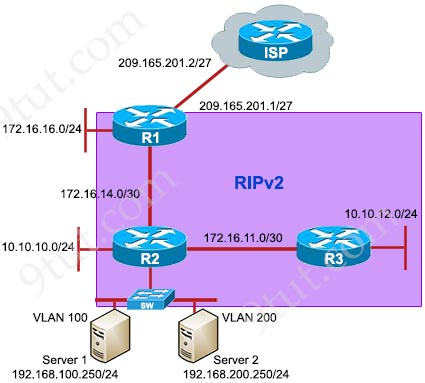
Question 1
Server1 and Server2 are unable to communicate with the rest of the network. Your initial check with system administrators shows that IP address settings are correctly configured on the server side. What could be an issue?
A. The VLAN encapsulation is misconfigured on the router subinterfaces.
B. The Router is missing subinterface configuration.
C. The Trunk is not configured on the L2SW1 switch.
D. The IP address is misconfigured on the primary router interface.
Answer: A
Explanation
Check the configuration of the interface that is connected to Server1 and Server2 on R2 with “show running-config” command.
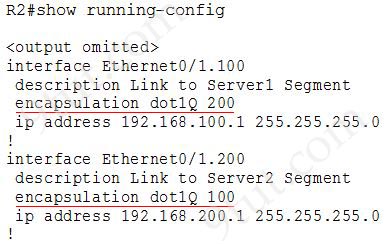
We see that subinterface E0/1.100 has been configured with VLAN 200 (via “encapsulation dot1Q 200” command) while Server1 belongs to VLAN 100. Therefore this configuration is not correct. It should be “encapsulation dot1Q 100” instead. The same thing for interface E0/1.200, it should be “encapsulation dot1Q 200” instead.
Question 2
Users in the main office complain that they are unable to reach internet sites. You observe that internet traffic that is destined towards ISP router is not forwarded correctly on Router R1. What could be an issue?
Ping to Internet server shows the following results from R1:
| R1#ping 209.165.200.225 Type escape sequence to abort. Sending 5, 100-byte ICMP Echos to 209.165.200.225, timeout is 2 seconds: ….. Success rate is 0 percent (0/5) |
A. The next hop router address for the default route is incorrectly configured.
B. Default route pointing to ISP router is not configured on Router R1.
C. Default route pointing to ISP router is configured with AD of 225.
D. Router R1 configured as DHCP client is not receiving default route via DHCP from ISP router.
Answer: B
Explanation
When all the users cannot reach internet sites we should check on the router connecting to the ISP to see if it has a default route pointing to the ISP or not. Use the “show ip route” command on R1:
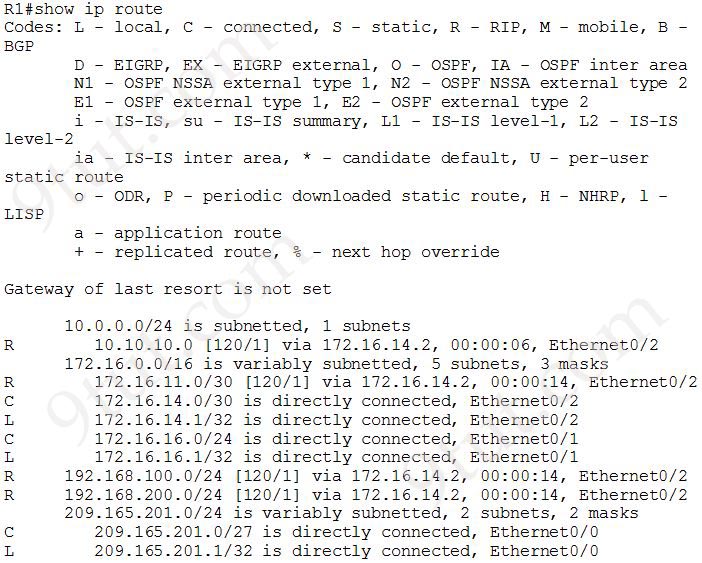
We cannot find a default route on R1 (something like this: S* 0.0.0.0/0 [1/0] via 209.165.201.2) so maybe R1 was not configured with a default route. We can check with the “show running-config” on R1:

We need a default route (like “ip route 0.0.0.0 0.0.0.0 209.165.201.2”) but we cannot find here so we can conclude R1 was not be configured with a default route pointing to the ISP router.
Question 3
Examine R2 configuration, the traffic that is destined to R3 LAN network sourced from Router R2 is forwarded to R1 instead R3. What could be an issue?
|
R2#traceroute 10.10.12.1 source 10.10.10.1 R2# |
A. RIPv2 enabled on R3, but R3 LAN network that is not advertised into RIPv2 domain.
B. RIPv2 routing updates are suppressed between R2 and R3 using passive interface feature.
C. RIPv2 not enabled on R3.
D. No issue that is identified; this behavior is normal since default route propagated into RIPv2 domain by Router R1.
Answer: C
Explanation
First we should check the routing table of R2 with the “show ip route” command.
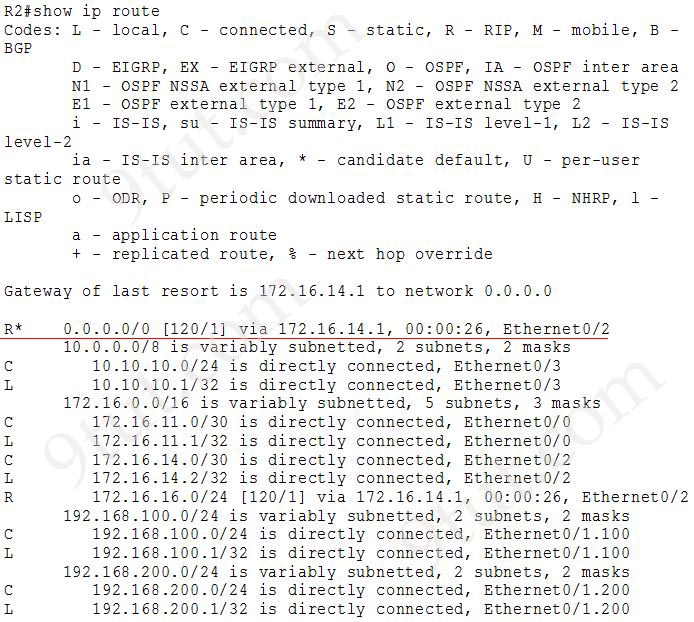
In this table we cannot find the subnet “10.10.12.0/24” (R3 LAN network) so R2 will use the default route advertised from R1 (with the command “default-information originate” on R1) to reach unknown destination, in this case subnet 10.10.12.0/24 -> R2 will send traffic to 10.10.12.0/24 to R1.
Next we need to find out why R3 did not advertise this subnet to R2. A quick check with the “show running-config” on R3 we will see that R3 was not configured with RIP ( no “router rip” section). Therefore we can conclude RIPv2 was not enabled on R3.
Question 4
What is the correct statement below after examining the R1 routing table?
A. Traffic that is destined to 10.10.10.0/24 from R1 LAN network uses static route instead RIPv2 because the static route AD that is configured is less than the AD of RIPv2
B. Traffic that is destined to 10.10.10.0/24 from R1 LAN network uses RIPv2 instead of static route because the static route AD that is configured is higher than the AD of RIPv2
C. Traffic that is destined to 10.10.10.0/24 from R1 LAN network uses static route instead of RIPv2 but the traffic is forwarded to the ISP instead of the internal network
D. Traffic that is destined to 10.10.10.0/24 from R1 LAN network uses RIPv2 instead of static route because the static route AD that is configured is 255
Answer: B
Explanation
Surely we have to use the “show ip route” command to check the R1 routing table.
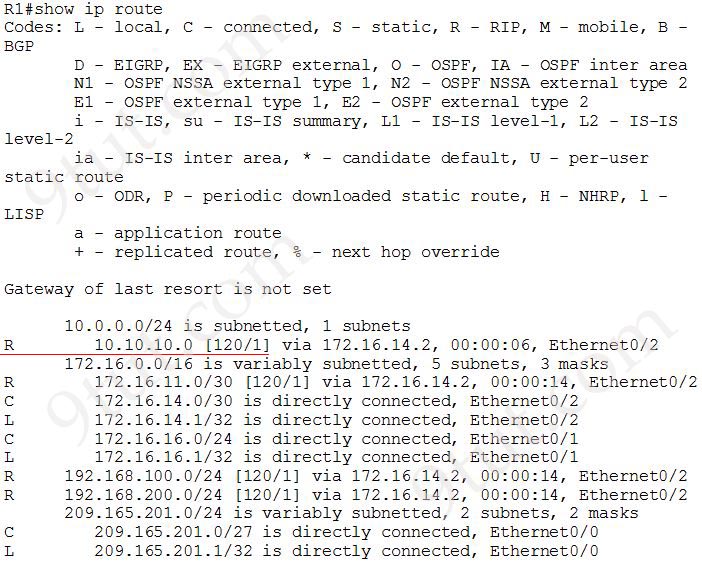
As we see here, 10.10.10/24 is learned from RIP. Notice that although there is a static route on R1 to this destination (you can check with the “show running-config” on R1 to see the line “ip route 10.10.10.0 255.255.255.0 172.16.14.2 200”), this static route is not installed to the routing table because it is not the best path because the Administrative Distance (AD) of this static route is 200 while the AD of RIP is 120 -> R1 chose the path with lowest AD so it chose path advertised via RIP.



Hello there, I understand the concepts listed here. My question is, when taking the exam, do we have to try and fix anything or just list the correct answers from looking at the configuration? Let me know. Thank you.
Just the correct answers for this one
I need the sim of this lab on packet tracer
Pleasw find my email below:
moneyandstuff42 @ yahoo . com
Can anyone forward latest CCNA dumps at hghiorsi at aol dot com. Thank you very much in advance.
Got this lab in my exam today!! Questions were little changed like R2 Router set as DHCP server but R3 not getting any IP from it. Answer was R3’s configuration was not set to recieve IP DHCP addressing from R2.
Another change was in in Q2 where the rel problem is related to wrong IP NAT interface configurations. Be very careful….all the crammers will have really hard time cracking CCNA.
Do it with real understanding please!!
Is this SIM valid ?
?
In Q2 it says a ping to internet server from R1#ping 209.165.200.225 fails.
In Exhibit the ISPs network appears as 209.165.201.2/27 so 209.165.201.0 NW. So the server was in another network (209.165.200.224) ?
@gaurav4u, do you have other recommendations? other questions were similar or the same?
@gaurav4u , questions you posted are literally from DHCP sim so no it was not this lab …